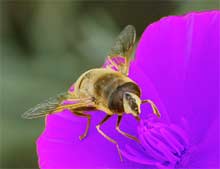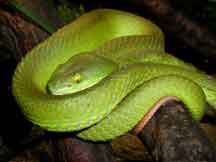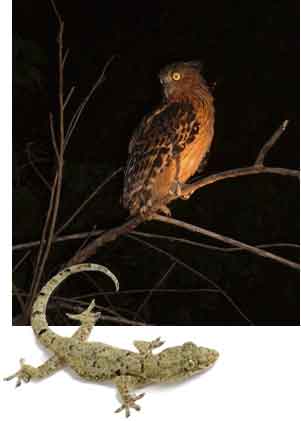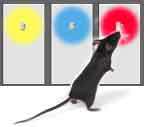Different animals have different kinds of color vision. Some have very poor color vision and others have very good color vision. In fact some birds and bees have super color vision and see colors that humans don't see.
Poor Color Vision and Animals
Dogs, cats, mice, rats and rabbits have very poor color vision. In fact, they see mostly greys and some blues and yellows.
 This is what humans see.
This is what humans see.
 This is what dogs & cats see.
This is what dogs & cats see.
What about bulls?
Does a red cape make them angry?
Does a red cape make them want to attack it?
 This is what humans see.
This is what humans see.
 This is what a bull sees.
This is what a bull sees.
Bulls are color-blind. They charge the red cape because it is moving, not because it is red.
Good Color Vision and Animals
Some animals do have good color vision. Monkeys, ground squirrels, birds, insects, and many fish can see a fairly good range of color. In some cases it's not as good as what we humans see - but it's much better than cats and dogs.

Scientists say that good color vision helps animals find food on the land or in the water. For land animals, good color vision helps to tell the difference between ripe red fruit and unripe green fruit. Colors can also make animals more attractive to each other when they mate. Finally, the ability to see colors helps animals identify predators (other animals who may attack them).
Who has super color vision?

Bees and butterflies can see colors that we can't see. Their range of color vision extends into the ultraviolet. The leaves of the flowers they pollinate have special ultraviolet patterns which guide the insects deep into the flower.
Another example is how a diving bird can see under water without goggles ... and you can't.
Which animal doesn't need eyes to see?
A pit viper sees by feeling the heat in an object.

Think about the last time you were really sick. Did you check your forehead to see if you were running a temperature? That "fever-heat" is what gives a pit viper a different kind of vision. This is called "thermal vision." (For more information at Color Matters, click New Frontiers for Color)
Learn more

E-books from the author of Color Matters
When are humans color-blind?
One out of 12 males are color blind.
Reds and greens are the most common colors that are difficult to see.
 Normal Color Vision
Normal Color Vision
 Color-blind Vision
Color-blind Vision
Humans are color-blind in dim light (such as night time with very little moonlight).

Who can see in the dark?
Owls and other nocturnal (night-time) animals can see at night when it is too dark for us. However, we do not know what animals actually see. We do know that they have very sharp vision.

Scientists recently discovered the first animal that can see some colors under very dim lighting. It's the gecko and it can tell blue from grey! It's possible that frogs might also see some colors when it's dark.
Source
How do we know what colors an animal sees?
Although there's no way to truly know what non-human animals actually perceive, scientists can examine the cones inside the eyes and estimate what colors an animal sees. One of the techniques used to determine the color vision of fish is “microspectrophotometry.” This process analyzes the visual pigments and photo-sensitivity of cells in order to determine how and what colors a fish sees.
For more information, see Look Inside the Eye
Scientists also test for color vision with behavioral tests.

In the picture above, a mouse has decided that the third colored panel looks different from the others and receives a drop of soy milk as a reward. For this set of three lights, only the soy milk dispenser over the red panel releases a drop of soy milk.
For more information about scientific studies see:
How Dogs are Tested for Color-Blindness
How do we know if a human is color-blind? See What is Color-Blindness at Color Matters.
Are you interested in color experiments ? See Science Projects
You might also be interested in:![]()
How does color affect your appetite? Can color help you lose weight?
See Color & Appetite Matters


